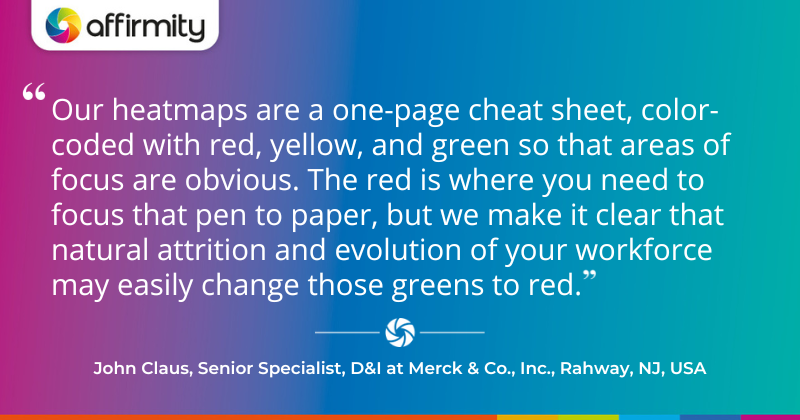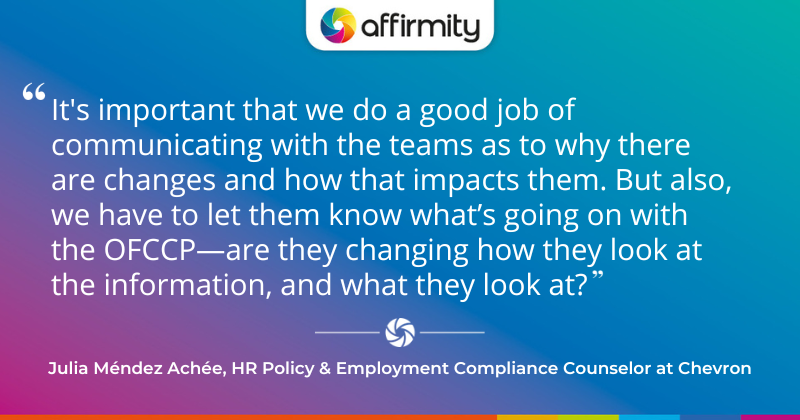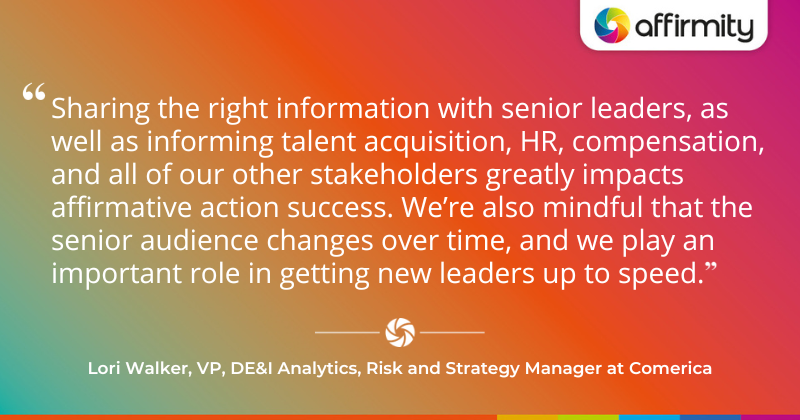Completing your organization’s affirmative action reporting is just the first step of your Affirmative Action Program journey. Over the following months, there are many further steps that an organization needs to consider. In this article, Mauri Spears, Affirmity Vice President of Consulting Services, has collaborated with compliance experts from Chevron, Merck, and Comerica to discuss how you can effectively manage the multi-faceted affirmative action program that follows.
How and Why You Must Go Beyond Annual Reporting
In the OFCCP’s Contactor Portal User Guide, you’ll find the following phrasing regarding your AAP obligations: “Contactors that meet certain contract dollar and employee thresholds have an obligation to develop and maintain Affirmative Action Programs (AAPs)”.
Note the wording is “programs”, rather than “plans” or “reporting”. Completing your organization’s affirmative action reporting is just the first step in your ongoing compliance program.
So what else should you be doing as part of this year-long journey? Here’s an overview of some of what you should be considering:
- Evaluating and distributing critical metrics to key stakeholders
- Reviewing and updating corporate policies and procedures
- Reviewing federal, state, and local reporting requirements
- Maintaining awareness of your organization’s federal contractors and revenue sources
- Audit preparation
- Ongoing evaluation and assessment of workforce sourcing efforts
As part of your organization’s AA program management, you will need to engage with areas of the organization that are outside of your area of expertise. The combined efforts of talent acquisition, data and IT teams, legal, organizational compliance, DE&I leadership, and others will need to be coordinated as part of your year-round responsibilities.
USEFUL AFFIRMATIVE ACTION REPORTING INFORMATION | ‘[Q&A] Are You Ready to Certify Your AAPs? Your Questions About the Portal and Process Answered’
What Programs Look Like in Practice: Experiences From Practitioners
One organization that embraces the 12-month program is Comerica. Lori Walker, VP, DE&I Analytics, Risk and Strategy Manager, describes the financial services corporation’s approach:
“We use data as a blueprint not only for our affirmative action plans, but for our diversity reporting, which is done per line of business or division. We leverage the same datasets but examine it under different lenses/views. This helps us understand where we have underutilization, adverse impact, pay disparity, and anything else that requires further investigation from all perspectives of our organization. The results inform our next steps, especially our Talent Pathways program.”
Biopharmaceutical company Merck & Co., Inc., Rahway, NJ, USA is another business focused on building a program rather than just a plan. John Claus, Senior Specialist, D&I, is regularly engaged in finding ways to keep program information relevant and in front of business partners:
“We certainly stress the active component in our program at the beginning of the year, but we also look at maintaining a relationship throughout the year. Different organizations will have different structures, and those structures can really dictate some of the relationships and the conversations you need to have in order to keep the information relevant. We particularly focus on working with other stakeholders to get the data we need upfront and consider how that data best informs our broader strategy.”
Julia Méndez Achée, HR Policy & Employment Compliance Counselor at Chevron, is similarly mindful of her department’s role in facilitating internal communication at the energy corporation. She describes her ongoing responsibilities:
“I communicate regularly with our talent acquisition team and legal group as well as other stakeholders in terms of compliance matters. We’ve been conducting more training particularly covering a number of key areas such as affirmative action and legal updates with regards to pay transparency. A lot of what I do is affirmative action compliance, but we’re also having to make sure that the other mandated federal requirements are taken care of: the EEO-1 report, VETS-4212, and state-mandated pay reporting. Then there’s also our mid-year monitoring reports, through which we connect with the right HR managers and business partners and inform them about how we’ve progressed since the beginning of the year. We have to make sure they understand what we’re giving them—in fact, I’m in the middle of creating a new training module to help them better understand those reports and what’s expected of them.”

7 Elements of Your Program’s Pathway to Success
So what components should organizations address or include in the management of a 12-month affirmative action program to ensure a “pathway to success”? We see there being at least seven key elements:
- Dissemination and strategy
- Training
- Outreach
- Monitoring progress
- Internal policy audit/review
- Audit preparation
- Additional reporting requirements
1) Dissemination and Strategy
Comerica provides a model example of communication strategy for affirmative action in its industry and at its organizational scale. On a quarterly basis, it communicates its diversity and affirmative action results to its executive diversity committee (consisting of the organization’s chief executives). Information is provided at both the overall organization and line of business levels. Lori Walker and her team then cascade these results to the next level of leadership, which is comprised of Comerica’s senior officers.
She explains further: “It’s not just limited to affirmative action, underutilization, adverse impact, pay equity, and candidate applicant information. We also look at other diversity metrics, such as performance reviews and employee resource groups, and consider them in relation to retention. Supplemental qualitative data, such as our “Voice of the Colleague” employee engagement survey, and our inclusion index, further inform our results and strategy.”
With so many different datapoints to communicate, organizations often find creative ways to make insights easier to digest. For Merck, this means heatmaps. John Claus acknowledges the challenge of getting stakeholder time: “We certainly got feedback like ‘This compliance and diversity work, it’s not the only work that we do, in supporting our clients.’ So you get bandwidth issues.”
He expands on Merck’s heatmap approach: “So how do you at least put forward the critical component that needs to be addressed? Our heatmaps are a one-page cheat sheet, color-coded with red, yellow, and green so that areas of focus are obvious”. The team is keen to emphasize that stakeholders aren’t being given a license to ignore yellow and green areas, however: “The heatmaps are like the classic ‘elevator pitch’—the red is where you need to focus that pen to paper, but we make it clear that natural attrition and evolution of your workforce may easily change those greens to red.”
LEARN HOW SOFTWARE CAN HELP YOU DISSEMINATE YOUR REPORTS | ‘How Affirmity’s TotalView Methodology Can Help You Maximize Management Visibility of AAPs’

2) Training
Structured training has a significant role to play in the ongoing affirmative action process: if the people who have to implement the plan don’t know what they’re looking at, or what they have to do, it’s not going to be very effective. It’s also important to help stakeholders understand any changes to the process, whether that’s a result of internal or external factors.
For example, due to recent organizational changes, Chevron is modifying its functional affirmative action plans (FAAPs), resulting in the elimination of one plan and name changes for several others. As Julia Méndez Achée says, “It’s important that we do a good job of communicating with the teams as to why there are changes and how that impacts them. But also, we have to let them know what’s going on with the OFCCP—are they changing how they look at the information, and what they look at? We’ve seen that recently with a renewed emphasis on outreach and recruitment efforts for veterans and individuals with disabilities.”
LEARN ABOUT TRAINING FOR AFFIRMATIVE ACTION COMPLIANCE | ‘What Are Your Training Obligations As a Federal Contractor?’
3) Outreach
One of the ways that organizations should be “working with” veterans and individuals with disabilities, as well as women and minorities, is outreach. As Julia Méndez Achée observes, the intensity of this particular task has changed a lot in recent years: “Back in the day, as long as you had a list of all the people that you sent letters to requesting their assistance in referring diverse talent, that was generally enough. Now you’re required to do an assessment of the effectiveness of your efforts.”
She further describes how she gets this extra depth of insight from her plan owners. “I created a survey form to collect information for the narrative document, asked to hear about what they did in the last year, informed them where they hadn’t reached targets for veterans or people with disabilities, and asked what they’re planning on doing the rest of the year. That got them thinking, and this was reinforced with training.”
While practitioners may traditionally think of outreach in terms of external activities, don’t underestimate the importance of internal efforts. Comerica’s “Talent Pathways” program uses many of the tactics you’d associate with an external program—it considers available talent pools, including through high schools in its various markets, and works with HBCUs and Hispanic-serving institutions. But it also offers diverse colleagues the opportunity to enroll in various development programs offered by external management consultancies and via partnerships with institutions and professional associations. Programs such as this ensure the organization isn’t relying on hiring alone to meet its goals.
4) Monitoring Progress
Ideas for monitoring progress have been woven throughout the description of the tactics above, but it nonetheless remains an important part of your ongoing responsibilities. The appropriate cadence for monitoring will vary from organization to organization—whether you settle on quarterly or mid-year monitoring, the important thing is that your progress needs to be measured and the metrics must be shared with the right people.
5) Internal Policy Audit/Review
Internal policy and audit review is perhaps one of the less glamorous tasks in your year-long program, but it’s nonetheless an important one. Legal updates can come from a number of different directions: new requirements at the federal level are the most obvious, but state and local laws may require your organization to change its policies. California pay data reporting provides an example that will be familiar to many. For a less regularly discussed example, did you know that half of U.S. states have passed the CROWN Act (“Creating a Respectful and Open World for Natural Hair”), protecting state government workers and job applicants from hair-based discrimination?
Julia Méndez Achée is a member of Chevron’s Policy and Compliance group. She reflects upon the importance of keeping track of changes at all these different levels. “It’s important because a lot of that impacts our policies. It’s about being mindful of those updates and making sure that our EEO statements are up to date. I’ve created a self-audit checklist for myself and it helps me make sure I’m checking these policies throughout the year.”
“Before Chevron, I consulted on hundreds—possibly thousands—of audits. I know that the OFCCP is looking at items such as the Family Medical Leave Act, or accommodations for religion. A lot of times organizations forget that these elements are something the OFCCP or other agencies can and will take a look at. We have to make sure our policies are still accurate and that everything is properly maintained—everything’s electronic, and every link must still be working and lead to accurate information.”
MORE ON PAY REPORTING | ‘Update: New State Obligations for Reporting California Pay Data’

6) Audit Preparation
Every year there’s a chance that your organization will appear on the Corporate Scheduling Announcement List (CSAL)—meaning that it has been selected for a routine audit. The OFCCP gives organizations just 30 days after receiving their scheduling letter to respond. Realistically, this means that you need to start preparing for an audit before you know you’re being audited—hence, audit preparation is a standard part of your year-round program.
This requires that both current and past reporting is in place, easy to pull, and simple to turn around within 30 days. John Claus cautions organizations about this 30-day period: “You can’t spend 29 days cleaning up your applicant tracking and one day to review it. Any attorney would say ‘you don’t turn anything over to any of the agencies before you review it yourself.’” You should be cleaning up data as part of ongoing processes, allowing more time for a robust review, and once again engaging with other people in the organization (including legal, and talent acquisition) to expedite the process.
7) Additional Reporting Requirements
As part of your year-round program, you’ll naturally be best positioned to support the wider business on a range of other non-affirmative action reporting activities. EEO-1 is a long-standing example, and again we must mention the wave of state-level pay reporting laws. With the substantial effort involved in all of the activities above, it’s also important not to downplay the connection with your organization’s broader DE&I initiatives.
As far as possible, you want to avoid having different groups siloed off from each other and not sharing data: it’s a waste of effort and potentially causes confusion.
KEEP READING ABOUT YOUR YEAR-ROUND RESPONSIBILITIES | ‘A Year in the Life of a Compliance Professional: 7 Key Affirmative Action Responsibilities’
Key Takeaways
Our contributors are rightly adamant that their work is about more than just reports—it’s about building a year-long program. We asked them to share their key takeaways from our discussion.
Lori Walker suggests that dissemination and strategy are the most important areas of an ongoing program: “Sharing the right information with senior leaders, as well informing talent acquisition, HR, compensation, and all of our other stakeholders ultimately greatly impacts affirmative action success. We’re also mindful that the senior audience changes over time, and we play an important role in getting new leaders up to speed, thereby maintaining our momentum.”
Julia Méndez Achée emphasizes the importance of training in augmenting this strategy: “Having those meetings, making sure people understand what’s expected of them, being clear and planning. You don’t want to wait until the last minute to say ‘hey, this is the work we’re going to do.’ It does involve a lot of planning.” She also reflects on the importance of staying aware of current best practices. “I do a lot of reading to keep up with everything going on. I go to a lot of webinars and conferences. It’s important for whoever is in this role to just make sure that they’re keeping up to date with any regulatory changes and announcements.”
John Claus encourages practitioners to refine their approach to dissemination. “We’ve been using Affirmity’s CAAMS® tool for decades—we’re constantly asking our contacts to give us feedback, which reports work, which don’t. CAAMS® has a lot of reports, and there’s a lot of information to disseminate, so we’re always looking at the best way to do that. Ultimately, your organization shouldn’t only know your name because an audit came up. They should know you because you regularly let them know what’s going on in the business.”
To get help with every aspect of your year-round AAP activity with our software and services, contact Affirmity today.
 About the Author
About the Author
Mauri Spears is Vice President of Consulting Services at Affirmity, providing leadership in workforce compliance, succession planning, and training management. She has managed process re-engineering initiatives for both workforce compliance and recruitment management. Ms. Spears oversees all of Affirmity’s consulting and implementation services and leads our data analytics team. She also drives corporate management, employee consulting, and training engagements.
